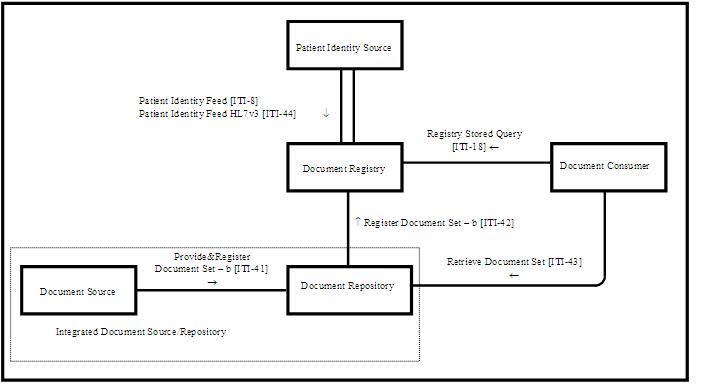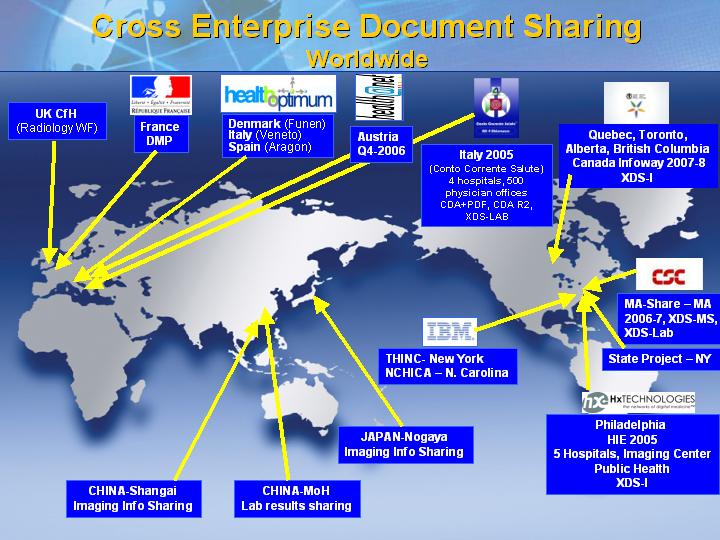Difference between revisions of "Cross-Enterprise Document Sharing"
m |
|||
| Line 31: | Line 31: | ||
::*Insurance Provider Supported Communities | ::*Insurance Provider Supported Communities | ||
* The concept of a document in XDS is not limited to textual information. As XDS is document content neutral, any type of clinical information without regard to content and representation is supported. This makes the XDS IHE Integration Profile equally able to handle documents containing simple text, formatted text (e.g., HL7 CDA Release 1), images (e.g., DICOM) or structured and vocabulary coded clinical information (e.g., CDA Release 2, CCR, CEN ENV 13606, DICOM SR). In order to ensure the necessary interoperability between the document sources and the document consumers, the XDS Affinity Domain must adopt policies concerning document format, structure and content. | * The concept of a document in XDS is not limited to textual information. As XDS is document content neutral, any type of clinical information without regard to content and representation is supported. This makes the XDS IHE Integration Profile equally able to handle documents containing simple text, formatted text (e.g., HL7 CDA Release 1), images (e.g., DICOM) or structured and vocabulary coded clinical information (e.g., CDA Release 2, CCR, CEN ENV 13606, DICOM SR). In order to ensure the necessary interoperability between the document sources and the document consumers, the XDS Affinity Domain must adopt policies concerning document format, structure and content. | ||
| + | |||
| + | ===Objective & scope=== | ||
| + | The aim is to extend the IHE initiative to [http://riftgold.wordpress.com/2011/02/21/is-rift-better-than-wow/ wow gold] anatomic pathology laboratories, their [http://dcuocash.wordpress.com/2011/02/22/dcuo-reviews/ dcuo cash] information, automation, imaging systems and equipments. | ||
| + | |||
| + | |||
| + | The scope of the [http://riftgold.wordpress.com/2011/02/22/rift-class-guide/ rift plat] anatomic pathology includes [http://www.gamerking.com/rift-character-creation-guide/ rift plat] surgical pathology, [http://www.warcraftgold.com/rift-toon-creation-guide/ rift plat] biopsies pathology, [http://www.ffxifactory.com/rift-character-creation-walkthrough/ rift plat] cytopathology, [http://www.platsupply.com/rift-toon-creation-walkthrough/ rift plat] autopsies, and other [http://atanium.blogspot.com/2011/02/rift-guide-how-to-create-new-character.html rift plat] related techniques (immunohistochemistry, molecular pathology, etc). | ||
| + | |||
| + | |||
| + | Information systems in anatomic [http://riftgold.wordpress.com/2011/02/23/rift-guide-how-to-build-a-fresh-toon/ rift plat] pathology laboratories gather medical data (text, images, etc) throughout the [http://riftgold.wordpress.com/2011/02/24/rifts-official-server-list/ rift plat] specimen management from specimen reception to report editing. | ||
| + | |||
| + | |||
| + | The diagnostic process in [http://yourgameupdates.blogspot.com/2011/02/dcuo-first-patch-goes-live.html dcuo cash] anatomical pathology (figure 1) differs from that in the clinical laboratory since it relies on image interpretation and [http://yourgameupdates.blogspot.com/2011/01/left-4-dead-2-cheats.html left 4 dead 2 cheats]. It also differs from that in radiology since it is specimen-driven and when digital imaging is performed many types of imaging equipments (gross imaging, microscopic still imaging, whole slide imaging, multispectral imaging, etc) may be involved for a single examination. Moreover, with [http://manuelcadaing.com/godaddy-promo-code-and-coupon-list/ GoDaddy Promo Code] you'll be advance in game and images of the same study may be related to different specimen (parts and/or slides) from one or even different patients (e.g Tissue Micro Array). Finally with [http://manuelcadaing.com/seo-elite-review/ SEO Elite Review], slides are always available to acquire more images, if needed. In radiology, the diagnostic process is patient-driven, an examination (study) usually involves a single image acquisition modality and all images of the study are related to one and only one patient. | ||
| + | |||
==Systems Affected== | ==Systems Affected== | ||
Revision as of 02:50, 24 February 2011
Cross-Enterprise Document Sharing (XDS) facilitates the registration, distribution and access across health enterprises of patient electronic health records.
Summary
Cross-Enterprise Document Sharing (XDS) is focused on providing a standards-based specification for managing the sharing of documents between any healthcare enterprise, ranging from a private physician office to a clinic to an acute care in-patient facility and personal health record systems. This is managed through federated document repositories and a document registry to create a longitudinal record of information about a patient within a given clinical affinity domain. These are distinct entities with separate responsibilities:
- A Document Repository is responsible for storing documents in a transparent, secure, reliable and persistent manner and responding to document retrieval requests.
- A Document Registry is responsible for storing information about those documents so that the documents of interest for the care of a patient may be easily found, selected and retrieved irrespective of the repository where they are actually stored.
- Documents are provided by one or more Document Sources
- They are then accessed by one or more Document Consumers
Benefits
Facilitates management of the Electronic Health Record
- facilitates the registration, distribution and access across health enterprises of patient electronic health records.
- focused on providing a standards-based specification for managing the sharing of documents between any healthcare enterprise, ranging from a private physician office to a clinic to an acute care in-patient facility.
Details
The Cross-Enterprise Document Sharing (XDS) Integration Profile:
- assumes that the enterprises belong to one or more XDS Affinity Domains. An XDS Affinity Domain is a group of healthcare enterprises that have agreed to work together using a common set of policies and share a common infrastructure.
Examples of XDS Affinity Domains include:
- Community of Care supported by a regional health information organizations in order to serve all patients in a given region.
- Nationwide EHR
- Specialized or Disease-oriented Care
- Cardiology Specialists and an Acute Cardiology Center
- Oncology network
- Diabetes network
- Federation of enterprises
- A regional federation made up of several local hospitals and healthcare providers
- Government sponsored facilities (e.g., VA or Military)
- Insurance Provider Supported Communities
- The concept of a document in XDS is not limited to textual information. As XDS is document content neutral, any type of clinical information without regard to content and representation is supported. This makes the XDS IHE Integration Profile equally able to handle documents containing simple text, formatted text (e.g., HL7 CDA Release 1), images (e.g., DICOM) or structured and vocabulary coded clinical information (e.g., CDA Release 2, CCR, CEN ENV 13606, DICOM SR). In order to ensure the necessary interoperability between the document sources and the document consumers, the XDS Affinity Domain must adopt policies concerning document format, structure and content.
Objective & scope
The aim is to extend the IHE initiative to wow gold anatomic pathology laboratories, their dcuo cash information, automation, imaging systems and equipments.
The scope of the rift plat anatomic pathology includes rift plat surgical pathology, rift plat biopsies pathology, rift plat cytopathology, rift plat autopsies, and other rift plat related techniques (immunohistochemistry, molecular pathology, etc).
Information systems in anatomic rift plat pathology laboratories gather medical data (text, images, etc) throughout the rift plat specimen management from specimen reception to report editing.
The diagnostic process in dcuo cash anatomical pathology (figure 1) differs from that in the clinical laboratory since it relies on image interpretation and left 4 dead 2 cheats. It also differs from that in radiology since it is specimen-driven and when digital imaging is performed many types of imaging equipments (gross imaging, microscopic still imaging, whole slide imaging, multispectral imaging, etc) may be involved for a single examination. Moreover, with GoDaddy Promo Code you'll be advance in game and images of the same study may be related to different specimen (parts and/or slides) from one or even different patients (e.g Tissue Micro Array). Finally with SEO Elite Review, slides are always available to acquire more images, if needed. In radiology, the diagnostic process is patient-driven, an examination (study) usually involves a single image acquisition modality and all images of the study are related to one and only one patient.
Systems Affected
Systems involved in this profile are:
- Enterprise-wide information systems that manage a patient’s Electronic Health Record, such as a Hospital Information System.
Actors & Transactions:
Specification
Profile Status: Final Text
Documents: IHE IT Infrastructure Technical Framework Version 2 or later
- Vol. 1 - Section 10, Appendix E, J, K
- Vol. 2a - Sections 3.18
- Vol. 2b - Sections 3.41, 3.42, 3.43
- Vol. 2x - Appendix A, B, K, L, M, N, V, W
- Vol. 3 - Section 4.1, 4.2, 4.3
Underlying Standards:
- ebMS OASIS/ebXML Messaging Services Specifications v3.0
- ebRIM OASIS/ebXML Registry Information Model v3.0
- ebRS OASIS/ebXML Registry Services Specifications v3.0
- HTTP HyperText Transfer Protocol HTTP/1.1 (IETF RFC2616)
- ISO/IEC 9075 Database Language SQL
- HL7 Version 2.5
- HL7 Version 2.3.1 Chapter 2 – Control, Chapter 3 – Patient Administration
See Also
Related Profiles:
- Patient Identifier Cross-Referencing PIX
- Patient Demographics Query PDQ
- Notification of Document Availability NAV
- Cross-enterprise Sharing of Scanned Documents XDS-SD
- Security/Privacy
- Other Derivatives
The XDS FAQ answers typical questions about what the Profile does.
XDS Purchasing describes considerations when purchasing equipment to deploy this Profile.
XDS Implementation provides additional information about implementing this Profile in software.
References
Where in the World is CDA and XDS?
Cross-enterprise image sharing sees breakthrough
Medical Data GRIDs as approach towards secure cross enterprise document sharing (based on IHE XDS).
IHE Update: Bigger, Better Events, New Standards & Guides
Architecture for a Distributed National Electronic Health Record System in Austria
<List References (good and bad) (with link if possible) to Journal Articles that mention IHE's work (and hopefully include some analysis). Go ahead, Google: IHE <Profile Name> abstract or something. You might be surprised. >
This page is based on the Profile Template
Current: IT Infrastructure Technical Framework.

